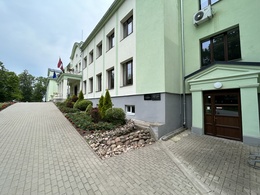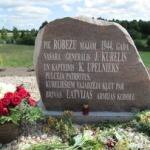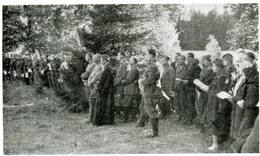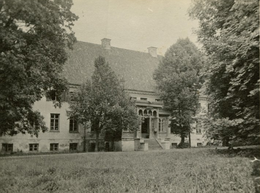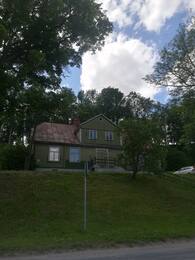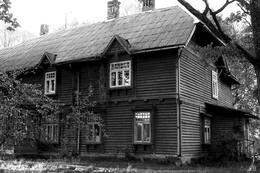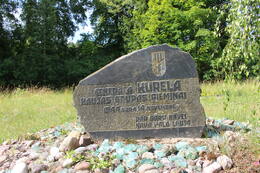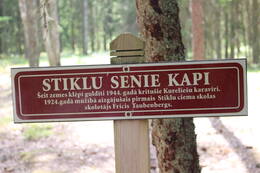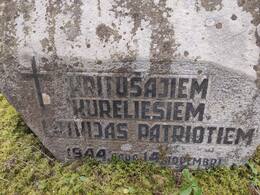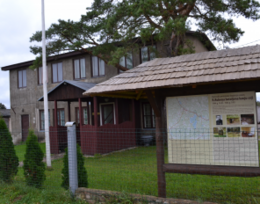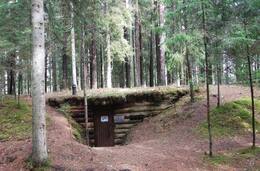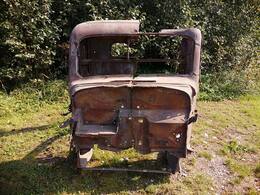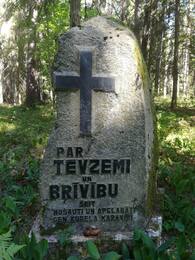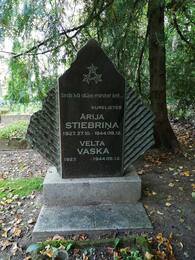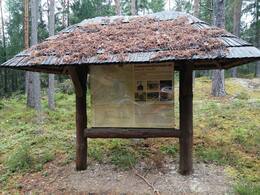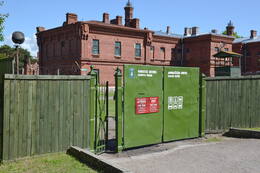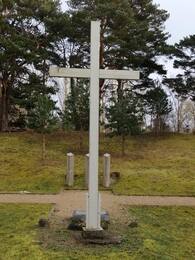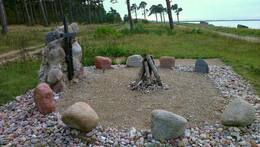Kurelieši: par Latviju pret svešām okupācijas varām
Memorial plaque at Malnava College
Memorial plaque near Malnava College, where 1932-1937 Lieutenant R. Rubenis studied in Opened in 2000
Memorial stone for Kurele people in Skriveri Parish
A memorial stone for the people of Kurele near the "Robežu" houses in Skrīveru Parish, opened in 2015. "Border" houses have not been preserved, there are only remnants of them.
"Robežu" houses in Skriveri parish
In the house of "Robežu" in Skriveri Parish is the place where the formation of the group of General J. Kurelis started on July 28, 1944.
Strazde manor
The Strazde manor is located on the side of the Riga - Ventspils highway and it was the location of the group of General J. Kurelis on September 29 - October 28, 1944.
Heavily rebuilt to meet the needs of the school (from 1922), it lost its original appearance and proportions during the rebuilding. Strazde Manor is surrounded by a beautiful park.
Yekeln's headquarters in Talso
On November 3, 1944, General J. Kurelis and Captain K. Upelnieks held talks with SS Obergrupenführer F. Yekeln and other German officers in this building in Talso. The historic building has been demolished, a new building is being built in its place.
Former shop/police building
The former store/police building in Talsos, where 14-19 of 1944 in November, the headquarters officers of General J. Kurelis' group were imprisoned.
Kurelian headquarters in Stiklos
During the Second World War in 1944, the Kurelian headquarters was located in the Annahite hunting castle in Stiklos. This building has survived to this day.
The surroundings of Stikli are rich not only with swamps and forests, but also with sand. In 1897, the new Annahites glass factory started its work - that's how this Latvian settlement got its name Stikli. In 1900, the so-called Annahite hunting palace, or the building where the factory manager lived, was built right there on the shore of Lake Stiklos.
A memorial stone for the people of Kurele in Stiklo
A memorial stone for Kurele people near Annahite hunting castle "Stiklos" in Puze parish, discovered in 1997, moved in 2023.
There is an information board with a QR code near the stone, where there is an audio guide's narration about the Kurelians.
Memorial site in the old Annahite Cemetery
Memorial place in the old Annahite cemetery, where the soldiers and civilians killed on November 14, 1944 as a result of the headquarters and main forces of the German besieging general J. Kurelis group are buried.
Memorials to the group of General J. Kurelis and Lieutenant R. Ruben in the "Dzelzkalnu" cemetery
Memorial stones for the group of General J. Kurelis and Lieutenant R. Rubenis in the "Dzelzkalnu" cemetery in Puze parish. Opened in 1997.
The memorial signs were installed even before the creation of the Rubenis Battalion Museum.
Rubenis' battalion museum
Rubenis’ Battalion Museum is located in Ugāle. It is dedicated to the Battalion of R. Rubenis, who served and fought under General J. Kurelis in Kurzeme in 1944, the activities of the Kurelians and the national resistance movement. Museum has an exhibit on the activities of the Latvian Central Council (LCC) and its Ventspils group, as well as the LCC Memorandum with 188 signatures and photographs of signatories that is included in the Latvian National Register of the UNESCO Memory of the World Programme. The LCC was a joint centre of Latvia's highest political leadership with an underground government that operated during the occupation of Latvia from 1943 to 1994. It was formed with the aim of coordinating the activities of various Latvian resistance movements in order to restore Latvia's national independence. The museum also offers a trip to places significant to the history of the battalion (settlement with a reconstructed bunker in the Usma parish, battlefields in Renda and Zlēkas parishes, etc.).
Rubenis' battalion bunker and battlefields
The restored dugout of the 2nd Company of the Rubenis Battalion is located in a forest by lake Ilziķi in the Usma parish. The dugout can be viewed from the outside for free at any time. However, tours inside the dugout must be booked in advance.
The Battalion of Lieutenant Robert Rubenis was part of a military unit formed by General Jānis Kurelis, and it is known for not surrendering to the German troops and showing heavy resistance. From November 14 to December 9 in 1944 fierce battles were fought in Ugāle, Usma, Renda and Zlēkas parishes between forces of the 16th German Army, SD and SS units under the command of the Police General Friedrich Jeckeln, and the battalion of the Kurelian unit commanded by Lieutenant Roberts Rubenis. The men under Rubenis’ command were well armed and organized and did not associate themselves with any of the two hostile occupying powers. Their actions are considered to be the most wide-spread and longest in the history of the Latvian national resistance movement. In battles near Renda and Zlēkas about 250 German soldiers fell, while only 50 casualties were suffered by Rubenis’ men. The events of those days are represented by the restored dugout in the forest (sod-covered, log cabin dug in the ground) where the men of the Rubenis Battalion once stayed.
The place of collision near Chubu's house in Renda parish
The clash of the 2nd company of Lieutenant L. Znutenas of the battalion of Senior Lieutenant V. Strautnieks with the Germans took place on November 16, 1944.
Graves of soldiers of Ruben's battalion
The graves of soldiers of Ruben's battalion are located by the highway Kuldīga - Sabile. A road sign and a stone with the inscription "For Your Land and Freedom" are located just a few hundred meters from the road.
The battalion of Lieutenant Robert Rubenis was one of the parts of the military unit formed by General Jānis Kurelis, which did not surrender to the German troops and showed fierce German resistance. During the Usma period, the numerical composition of the battalion increased to 650 men with four fully equipped companies, an ambulance and a farm team. Commanding staff: lieutenant R. Rubenis, lieutenant Filipsons, vv A. Druviņš, vv Šults, vv Briedis, vv. sergeant J. Rubenis, J. Bergs, vv Jaunzems.
From November 14 to December 9, 1944, fierce battles took place in the parishes of Ugāle, Usma, Renda and Zlēki between units of the German 16th Army, SD and SS units under the command of police general Friedrich Jekeln and a separate battalion of the Kurelian unit commanded by lieutenant Roberts Rubenis. Around 250 German soldiers were killed in the battles near Renda and Zleki, while the losses of the Rubenes were around 50 people.
After the death of Lieutenant Rubenis, Druviņš announced to his men that he would continue to work on a voluntary basis and as a result, several dozen men made the decision to separate from Rubenis' battalion. On November 20-21, 1944, a group of 11 people was captured by a German SD unit and after interrogations they took them to the local forest and shot them.
Monument to the paramedics of Ruben's battalion
Ārija Stiebriņa and Velta Vaska, paramedics of the Rubeņa battalion, were reburied in the Cirkale cemetery, who were shot by German Nazi army units on December 9, 1944, together with other residents, deserters, etc. captured in the vicinity of Zlēki.
According to the stories, it follows that the young women have joined Ruben's battalion voluntarily. Together with Ruben's battalion, they went from Suntaži to Usma. However, during the Jekelna campaign, the young women were arrested on the road, taken to the forester's house in Vēlogi for questioning and shot together with a small group of other detainees. A woman, a resident of Cirkale, knew Arya and managed to rebury the remains of both girls at the edge of the Cirkale cemetery and took care of this cemetery throughout the Soviet occupation.
Under the leadership of SS-Obergruppenführer and General of Police Friedrich Jäckeln, head of the German 16th Army's counter-intelligence division, the top SS and police chief in Ostland, a large-scale operation took place in the Eichensumpf ("Oak Swamp") from December 5 to 9, which was directed against the "Red Arrow" and General The remnants of the Kurelis group near Abava.
The progress of the action is partially documented in the report of December 31, 1944.
The site of the battle of the Ruben battalion on November 18, 1944, near Pērkoni's house
A memorial site at the site of the November-December 1944 battles of Lieutenant R. Ruben's battalion between the houses of "Vēvera" and "Dzilna" in Ugāle parish.
The site of the battles of Ruben's battalion on November 18, 1944
Memorial place at the site of the battles of Lieutenant R. Rubeņas' battalion on November 18, 1944, between the houses of "Pērkon" and "Mežzīļu" in Renda parish.
Karosta Military Prison
The Karosta Prison in Liepāja is the only military prison in Europe open to tourists. Constructed around 1900 for the needs of a hospital, the building was never used for its original purpose. The structure was repurposed as a place for serving temporary disciplinary punishment and was used as such up until 1997.
Powers changed but the purpose of the institution remained the same, namely, to house prisoners, including revolutionaries, sailors and non-commissioned officers of the Russian tsarist army, German deserters, enemies of the people of the Stalin era, as well as soldiers of the Soviet and Latvian armies. The Karosta Prison is currently open to visitors and guided tours are available. The tours show the prison and visitors can learn about its history, have a look at the prison and punishment cells and hear interesting and even ghostly tales about life at the prison. Braver souls have the opportunity to play the ‘Behind the Bars’ reality game or try to get out of closed rooms. And those who know no fear can spend the night in a prison cell. The Karosta Prison has a Karosta Visitor Centre, a Soviet-era buffet and a souvenir shop. The services of a guide are available throughout the whole of Karosta.
The white cross and the place of execution in Karosta
The white cross and the place of execution in front of Liepāja's Karosta prison. Opened in 2000.
The place where General Kurelis's staff officers were shot
At the end of July 1944, when the Red Army invaded the territory of Latvia, the German occupation authorities allowed Jānis Veide, the Riga District Police Chief and Commander of the 5th Riga Guards Regiment of the restored Latvian Guards Organisation, to establish the "General Kurelis Group of the Riga Guards Regiment". The head of the Military Commission of the Central Council of Latvia, General Jānis Kurelis of the Latvian Army, became its leader.
The Kurelis operated in Vidzeme until September 1944, when they moved to Kurzeme, where they were stationed in the houses of Stiklis in Puzes parish, Ilziķi in Usma parish, Iliņi in Ģibuli parish, and in Edole and other places in Northern Kurzeme. By the end of October 1944, the Kurelies had about 3,000 armed men, among them many former soldiers of the Latvian SS Volunteer Legion units, who joined the unit to realise their dream - the fight for Latvia's independence.
At the beginning of November 1944, the German occupation authorities' Supreme Police and SS leader in Ostland, SS Oberruppenführer Friedrich Jeckeln, began to restrict the group's activities and on 14 November arrested the Kurelian headquarters and more than 700 soldiers in Stikliai, Puse parish. The battalion commanded by Lieutenant Robert Rubens, with about 500 men in the Usma area, resisted and continued fighting until December 1944.
On the night of 19/20/1944, the Germans fought against the Germans. On November 19-19, 1944, a court-martial of the German occupation authorities was held in Liepāja Karaostas Prison, sentencing to death eight staff officers of General Kurelis' group - Colonel Pēteris Liepiņš, Captain Kristaps Upelnieks, Captain Jūlijs Mucenieks, Lieutenant Jānis Gregoras, Lieutenant Teodorma Prikulis, Lieutenant Jānis Rasas, Lieutenant Filipson and Adjutant Kārlis Valters. Three staff officers, Lieutenant Colonel Eduards Graudins, Lieutenant Arthurs Ankravs and Sergeant Vili Pavulāns, were pardoned for various reasons. On the afternoon of 20 November, the convicts were shot in the dunes near the Karosta prison, where a white cross can be seen today.
In 1994, a memorial to the officers who were shot was established in the dunes of the Liepaja Karosta. In 2012, after it was washed into the sea, the memorial was restored to its present location.
*** Translated with www.DeepL.com/Translator (free version) ***



